5. The Hunchback of Notre Dame (1923)
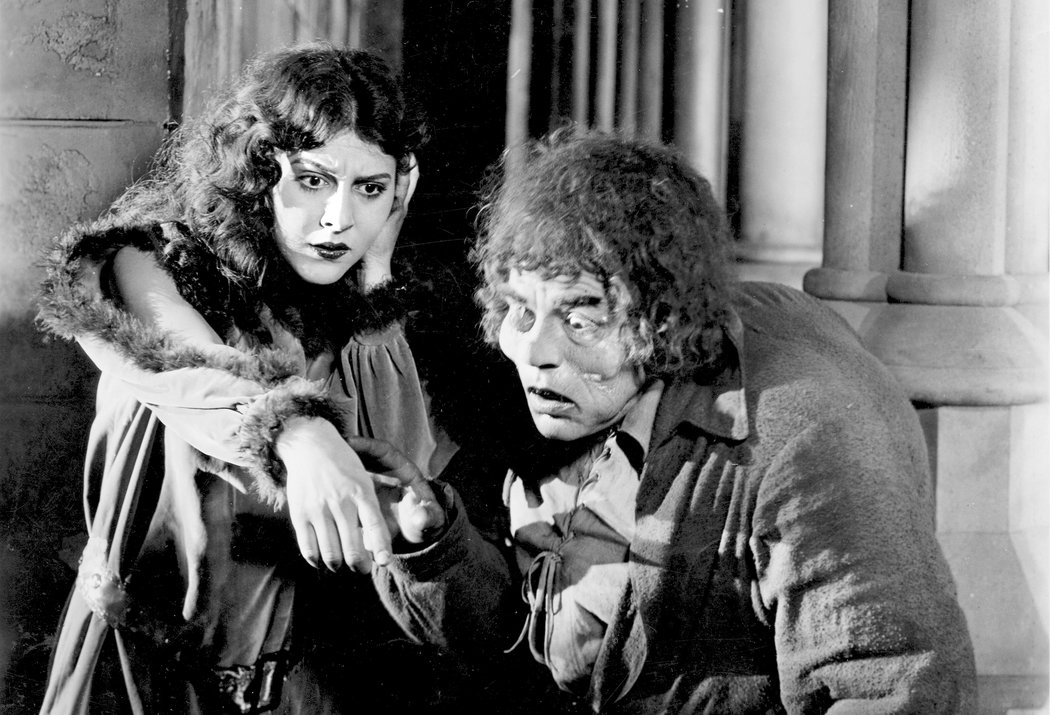
1923’s Hunchback of Notre Dame may be more of a straight-forward adaption than the other movies on this list, but that doesn’t make it any less of a horror movie. Instead, it takes the darker aspects of the novel and exaggerates them for shock value. Quasimodo isn’t just ugly; he’s ghastly.
The camera lingers on his twisted, wide-eyed face as Esmeralda screams and runs away. His master isn’t just a self-righteous hypocrite; he’s a nostril-flaring madman with all sorts of gross intentions. So much of this film is built around shock value, and it all works. Horror legend Lon Chaney (Phantom of the Opera, father of the Wolf Man) stars in what would become Universal Studio’s most successful silent film. He’s a man of a thousand faces, and every one of them is hideous.
Rather than attempt to do justice to the epic tragedy of the original novel, director Wallace Worsley wisely decided to streamline the narrative into a tight thriller where Esmeralda herself is the McGuffin that everyone wants. Quasimodo pops out of the shadows to kidnap her. Jehan (not Frollo) plots to have her for himself. Phoebus swoops in to save her.
People get stabbed and beaten and killed, and it’s all because of Esmeralda. The story is simple, which leaves the emotional heavy-lifting to the wildly expensive sets, the amazing silent film acting, and the ever-present shadows of a world that’s just a little bit creepier than reality.
4. Alice (1988)
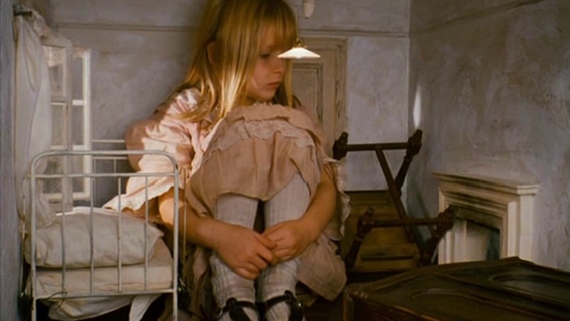
Surprisingly, there aren’t any straight horror adaptations of Alice’s Adventures in Wonderland, at least in movie form. There are plenty of books and video games that skew toward horror, and many of the films at least partially embrace the darkness, but an unqualified horror adaptation simply doesn’t exist yet. That doesn’t mean there isn’t an absolutely terrifying movie version out there. It’s just a little too unclassifiable to be labeled horror.
In 1988, Czech auteur Jan Svankmajer released Alice, his first feature length film. He uses actors and stop motion to create the most unnerving version of Wonderland in cinema. The White Rabbit is a taxidermied bunny—filled with sawdust—who follows the Queen’s orders by chopping off heads with a rusty pair of scissors.
Everything in Wonderland is made from grimy household objects, making the whole place feel dangerous and nauseating. Even the ending—the most iconic “it was all a dream” ending in literature—is portrayed as off-kilter, as the viewers don’t know whether Alice’s room is real or just another part of her creepy hallucination.
Like the best horror-related adaptations, Alice takes a familiar story and makes it off-putting, using the viewers’ familiarity against them. After an hour and half of nauseating images and jarring cuts, absolutely no one wants to stay in this Wonderland any longer.
3. Snow White: A Tale of Terror (1997)
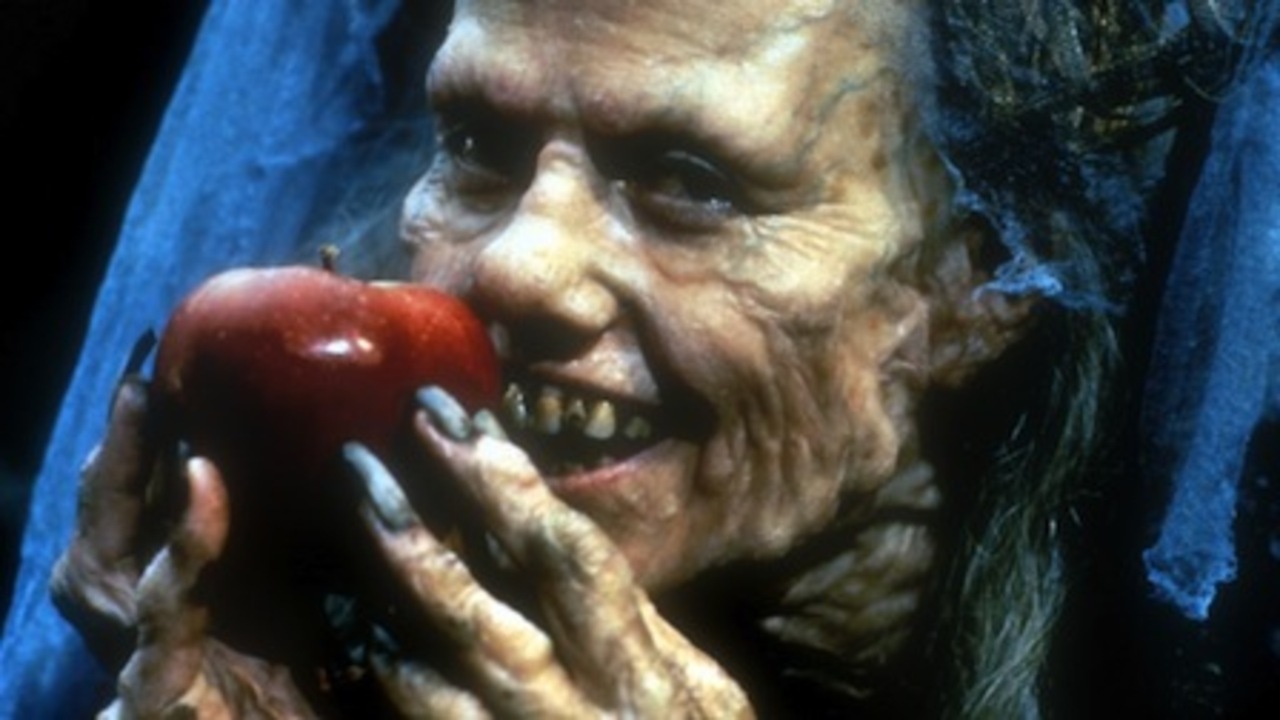
It’s not hard to guess why Oscar-nominated Sigourney Weaver would sign on for a modestly budgeted horror movie: she gets to have the time of her life chewing the scenery as the most murderous version of the evil queen in cinema history. Not only does she play the beautiful, bitchy version of the character, but she plasters her face in fake wrinkles and morphs into the old crone version of the same character. She’s the single bright spot in a dark, dark movie, and viewers can tell that she’s having a blast.
From the earliest scene—when Snow White’s pregnant mother dies in a carriage accident and Snow is born by bloody caesarian, the movie is clear about its motives: to gross out viewers as thoroughly as possible. The seven dwarfs have been upgraded to miners who (for the most part) die grisly deaths. The evil queen is so upset at Snow during a dinner party that she has an anger-related miscarriage. The movie is as far away from the Disney cartoon as possible, but it’s also a huge departure from the Grimm Brothers’ story.
It’s almost a cliché to point out the dark undercurrents of Western fairy tales. Yes, it’s true that Cinderella’s stepsisters hack off toes and heels in order to fit into the glass slipper. Yes, it’s true that the Goose Girl gets advice from a magical horse head that sits rotting against a fence. And yes, it’s true that the tale of Snow White has that same kind of darkness. Even the Disney adaptation talks about cutting out a young girl’s heart.
This movie, however, takes things to a completely different level. The original story was about suffering through hardships until you get a happy ending. The world is tough, and young girls needs to grin and bear it. In the movie, the world isn’t just tough. It’s terrifying. Aside from Snow, no one gets a happy ending. It doesn’t teach children any lesson, except perhaps to watch out.
2. The Strange Case of Dr. Jekyll and Mr. Hyde (2006)
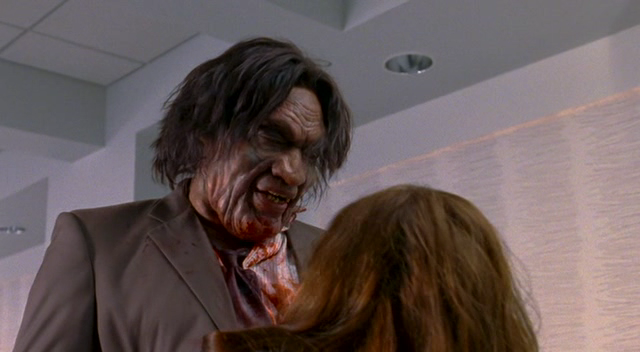
Robert Louis Stevenson’s 1886 novella The Strange Case of Dr. Jekyll and Mr. Hyde isn’t a horror story, per se, but it is horror adjacent. It follows the downward spiral of a respected scientist who uses chemicals to temporarily change into a darker, more animalistic persona. Things spiral out of his control, and his story ends tragically.
The 2006 film of the same name follows the same basic structure, but its version of Hyde is much more murderous. This adaptation casts horror icon Tony Todd (Candyman, Final Destination) as the titular scientist. Considering that the film takes place in modern times and stars an African American actor, the filmmakers could’ve added some racial subtext that was absent from the source material. Instead, they opt to focus more attention on spurting arteries and female college students in danger.
Aside from tone, the biggest difference between book and film is the look of Mr. Hyde. While the literary Hyde is just a blunter-looking version of Jekyll, the movie version is a full-blown monster. No one believes Jekyll when he says they’re the same person, because they don’t even look like the same species. Like the rest of the movie, the entire concept of Hyde has been heightened to showcase gruesomeness over complexity.
1. Phantom of the Opera (1989)
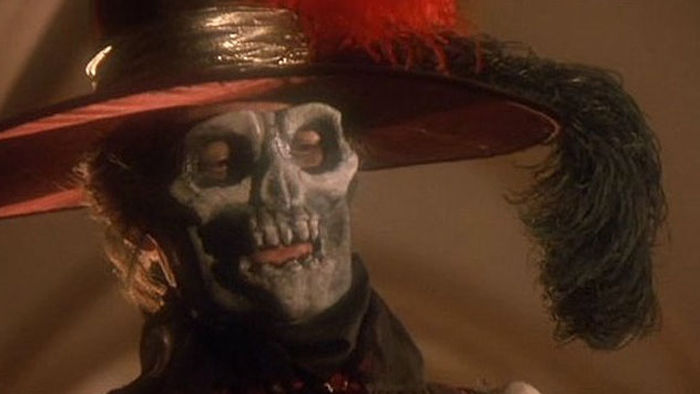
When you think of actor Robert Englund covered in horrible burn make-up, you probably think of Nightmare on Elm Street’s Freddy Krueger. The son-of-a-hundred-maniacs has been such a pop culture presence for so long, it’s hard to detach the actor from his role. However, in 1989, Englund played another hideously scarred horror icon: the Phantom of the Opera.
Based on Gaston LeRoux’s 1910 French novel, the cinematic Phantom follows a disfigured man who lives under the opera and becomes obsessed with a young starlet. While the novel builds its tragedy from telling the story of a misunderstood monster through shifting viewpoints, the movie is light on tragedy and heavy on giddy scenes of blood-soaked revenge. Much like the later Nightmare sequels, Englund dispatches the innocent with a variety of weapons and one-liners.
While the movie’s tone hews closer to Nightmare than the original novel, the plot itself is surprisingly faithful to LeRoux’s original vision. That, in a nutself, is what makes this Phantom a perfect example of a horror update of classic literature: take the story that everyone knows and update it with a few extra decapitations.
Author Bio: Evan Purcell is the headmaster of an elementary school in Zanzibar, the island region of Tanzania. He writes film criticism, as well as horror stories and the occasional trashy romance novel. Check out his work at EvanPurcell.Blogspot.com.